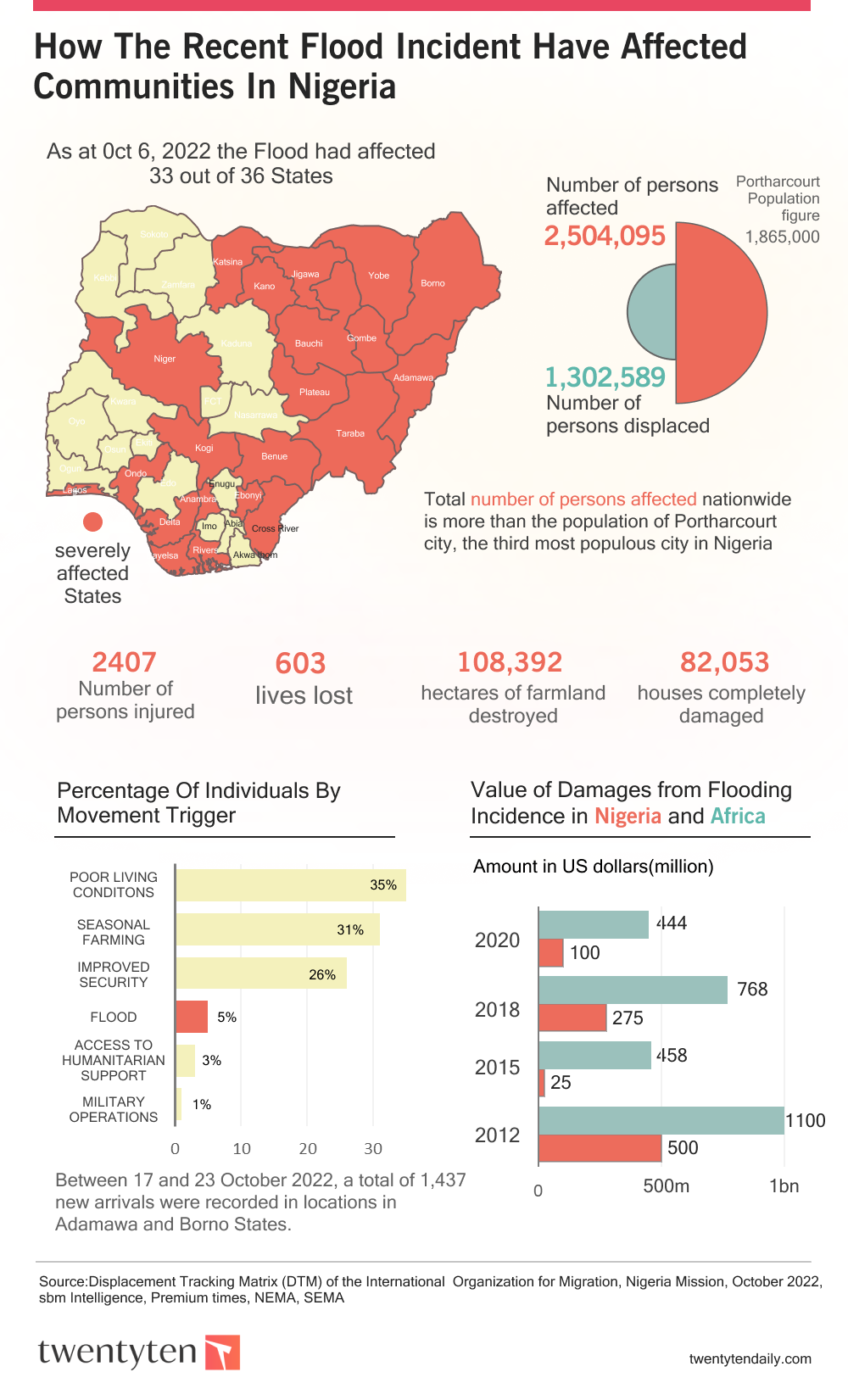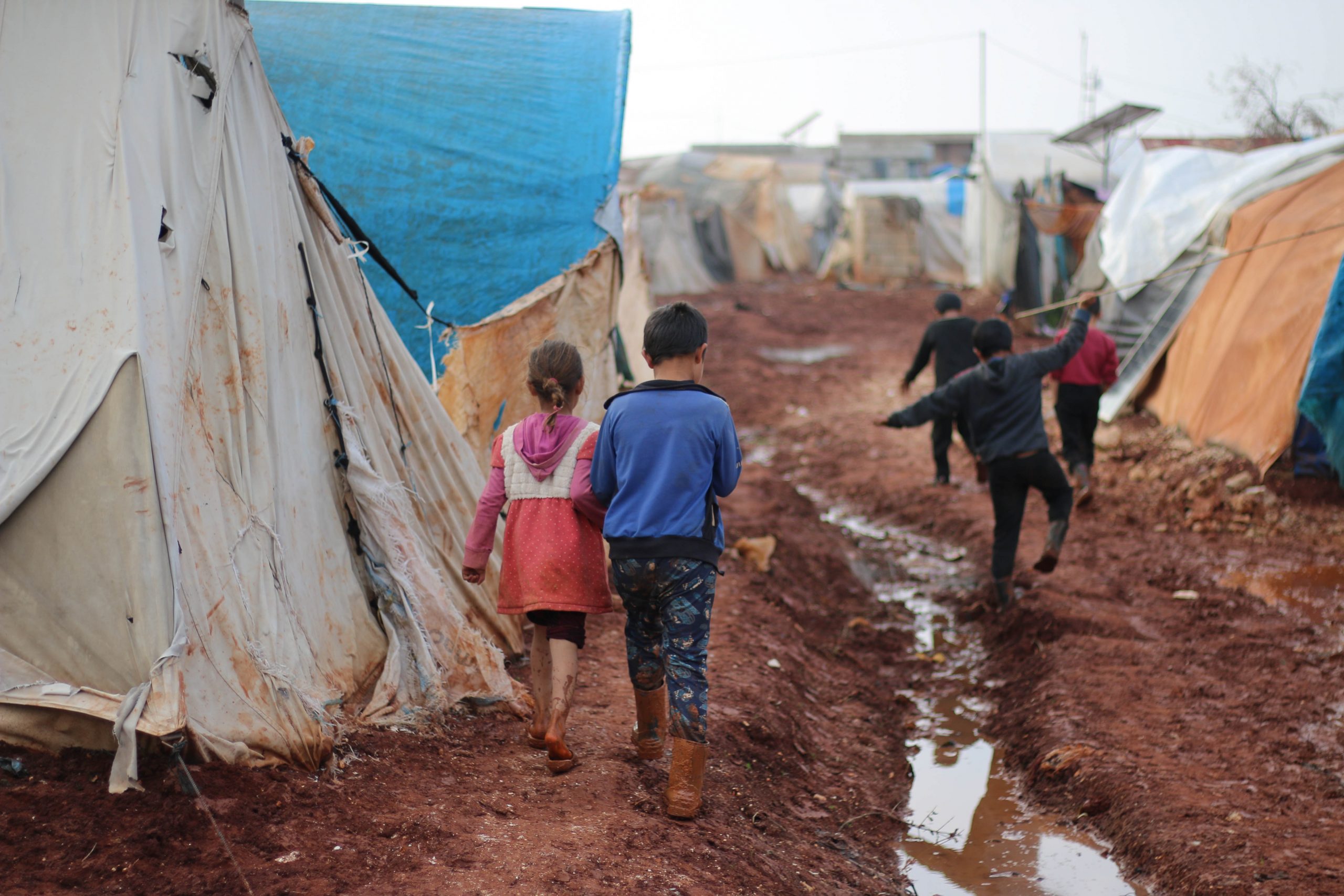Nigeria’s Flood: Visualizing The Numbers
Nigeria experienced the worst flooding occurrences the West African nation has seen in decades. This report amplifies the numbers reported by authorities that suffered the impacts.
Lawrence Office, 37, a father of three children was displaced from his home in Bayelsa state by floodwater. As he watch his house submerge, he was left with no other option than to move his family to his friend’s house.
In total, there are nine people (two families) surviving in a mini-falt house due to the impact of flooding.
Bayelsa state is just one of the 33 states out of 36 reportedly affected by flood in 2022. Many of the states affected were unprepared for the overwhelming sister than displaced over 1.4 million people around the country.
But this is not all.
The flooding which started in September is expected to subside in November. This is, however, not the first time the country would be experiencing flooding but this year is significantly worse than the past.
More than 200,000 homes have been destroyed and over 600 people died from the impact.
The National Emergency Management Agency estimated that 2.5 million people were affected by the flood; 2,407 persons were injured, 108,392 hectares of land were destroyed and 82,053 houses were completely damaged.
It is estimated that about 110,000 agricultural lands have been destroyed while food prices in affected communities are inflated by 23 per cent.
The flood is also causing outbreaks of diseases like Cholera, malaria, and environmental contamination in some IDP camps.
The Lagdo dam impact
On September 13, the Cameroon authorities opened its Lagdo dam to release excess water stored in it. Opening the dam is a periodical function meant to relax the pressure of the dam resulting from the rising water stored.
Construction of the Ladgo dam started in 1977 and was completed in 1982. As part of the construction process, Nigeria was supposed to build a dam in Adamawa, Dasin Hausa dam, to control the excess water coming from the Lagdo dam.
The Nigerian dam was meant to be two and a half the size of what was constructed in Cameroon. However, the negligence of the Nigerian government halted this process.
The Ladgo dam connects to the River Benue and other tributaries that lead to state and small communities. It is most consequential that the opening of the dam this year forced the impact of flooding in some states that the River Benue passes through.
States like Kogi, Benue, Adamawa, Bauchi, Borno, Gombe, Taraba, and Yobe were majorly impacted by this release.
However, the Minister of Humanitarian Affairs, Disaster Management and Social Development, Hajia Sadiya Farouq said Nigeria will “initiate a bilateral discussion with authorities in Cameroon in November 2022 on the periodic opening of the Lagdo Dam”.

Ecological fund
Beyond the infrastructural responsibilities that were ignored, concerns have also been raised about the ecological funds released to states to mitigate some environmental problems.
These problems include soil erosion, flood, drought, general environmental pollution, storms, tornadoes, bushfire, and earthquakes.
However, the recent flooding has raised questions on how these funds are being spent by stats.
According to the National Bureau of Statics Monthly Federation Account Allocation Committee report, between 2012 and 2021, Nigeria set aside a total of N548 billion for the derivation and ecological fund account for the 36 states in the country.
The ecological fund was created in 1981 through the Federation Account Act. At inception, 1 per cent of revenues into the Federation Account was set aside for the fund but in 1992, it was increased upward to 2 per cent of federal earnings.
Also, between February 2021 and June 2022, a total of N8.46 billion was released to the Nigeria Delta states (17 months).
Abia received N886.21 million, AkawIbom N1.05 billion, Bayelsa N837.39 million, Cross River N957.71 million, Delta N960.95 million, Edo with N884.94 million, Imo N983.96 million, Ondo N881 million and River with N1.02 billion.
Climate Change Occurrences
While the dam played its role in submerging some communities, the impact of climate change has also been most significant in exacerbating the casualties caused.
Researchers say that climate change can likely increase the frequency and intensity of rainfall which increases water levels. Global warming is causing extreme weather and sea level rise that can displace people living in coastal and inland communities.
World Weather Attribution (WWA) consortium said that the floods, among the deadliest on record in the region, were directly linked to human activity that is exacerbating climate change.

They matched long-term data on climate, which shows the planet has warmed by about 1.2 degrees Celsius since 1800 as carbon emissions have risen, against weather events.
Africa is home to some countries that are least responsible for carbon emissions contributing to climate change disasters. However, these countries bear more impact.
Nigeria’s climate has been changing in recent years. There are increases in temperature; variable rainfall; rise in sea level and flooding; drought and desertification; land degradation; more frequent extreme weather events; affected freshwater resources and loss of biodiversity.
There is, however, a need for a better response to mitigation, adaptation and capacity building to control the effect.
Flooding beyond Nigeria
While Nigeria was reported to be the most impacted country in Africa, other countries have suffered their fair share in this climate disaster.
Data on displaced persons gathered from Floodlist showed that in Ethiopia, 180,000 were affected, South Sudan with 1,000,000 people, Chad with 98,785 people, Cameroon with 150,000 people, Benin with 73,000 people and Ghana with 1,500 people.
Also, in the Central African Republic, 85,300 were displaced, Mali 3,000 people, Niger 227,000 people, Guniea 2,576 people, The Gambia 37,104 people, Sierra Leone 600,000, Sudan 226,200, Mauritania 4000, Mozambique 100,441, and Democratic Republic of Congo 13,000 people.



